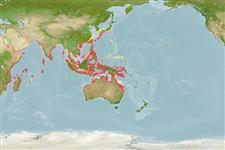Common names from other countries
Environment: milieu / climate zone / depth range / distribution range
Écologie
Récifal; profondeur 0 - 12 m (Ref. 100949). Tropical
Indo-West Pacific.
Length at first maturity / Taille / Poids / Âge
Maturity: Lm ? range ? - ? cm Max length : 8.0 cm SHL mâle / non sexé; (Ref. 349); common length : 6.0 cm SHL mâle / non sexé; (Ref. 349)
Regularly collected for food and shellcraft in many countries of the Indo-West Pacific area (Ref. 349). Among rocks and under stones, in rocky shores. Also found in shallow subtidal depths. Sometimes very common (Ref. 349). Feeds on epilithic algae by grazing (Ref. 85382). Found in intertidal, on rocks (Ref. 75835).
Life cycle and mating behavior
Maturité | Reproduction | Frai | Œufs | Fécondité | Larves
Members of the order Patellogastropoda are mostly gonochoric and broadcast spawners. Life cycle: Embryos develop into planktonic trocophore larvae and later into juvenile veligers before becoming fully grown adults.
Poutiers, J.M. 1998. (Ref. 349)
Statut dans la liste rouge de l'IUCN (Ref. 130435)
statut CITES (Ref. 108899)
Not Evaluated
Not Evaluated
Menace pour l'homme
Harmless
Utilisations par l'homme
Pêcheries: commercial
| FishSource |
Outils
Plus d'informations
Taille/Âge
Croissance
Longueur-poids
Longueur-longueur
Morphologie
Larves
Abondance
Sources Internet
Estimates based on models
Preferred temperature
(Ref.
115969): 24.8 - 29.3, mean 28.5 (based on 2592 cells).
Vulnérabilité
Low vulnerability (10 of 100).
